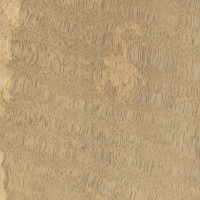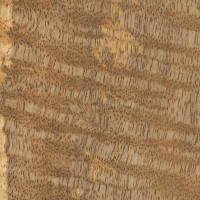 |
Common Name(s): Mango, Hawaiian Mango
Scientific Name: Mangifera indica Distribution: Tropical Asia and Oceania Tree Size: 80-100 ft (24-30 m) tall, 3-4 ft (1-1.2 m) trunk diameter Average Dried Weight: 42 lbs/ft3 (670 kg/m3) Basic Specific Gravity: .55 Hardness: 1,120 lbf (4,980 N) Rupture Strength: 13,300 lbf/in2 (91,720 kPa) Elastic Strength: 1,673,000 lbf/in2 (11,540 MPa) Crushing Strength: 6,890 lbf/in2 (47.5 MPa) Shrinkage: Radial: 2.5%, Tangential: 5.4%, Volumetric: 8.1%, T/R Ratio: 2.2 |
Color/Appearance: Because of the spalting that is commonly present, Mango’s heartwood and sapwood can be a kaleidoscope of colors. Most common are light and dark brown, while other colors such as yellow and streaks of pink and/or black can also occur.
Grain/Pore: Has a fine to medium texture, with straight grain: though the grain can also be interlocked and/or figured. Curly and spalted Mango is frequently seen.
Endgrain: Diffuse-porous; medium pores in no specific arrangement; solitary and radial multiples of 2-3; tyloses and heartwood deposits occasionally present; growth rings may be distinct due to the presence of marginal parenchyma; rays barely visible without lens; parenchyma may be banded (marginal), paratracheal parenchyma vasicentric, aliform (lozenge), and confluent.
Durability: Mango is rated anywhere from moderately durable to perishable. However, Mango is also susceptible to both fungal and insect attack.
Workability: Mango has a fairly high silica content and will readily dull the cutting edges of blades. There can also be reaction wood that can shift as it is being sawed, causing binding on the blade. Mango glues and finishes well, but can be difficult to work with when the grain is interlocked.
Scent: There is no characteristic odor associated with this wood species.
Safety: There have been no adverse health effects associated with Mango. See the articles Wood Allergies and Toxicity and Wood Dust Safety for more information.
Price/Availability: As an imported wood, Mango’s price tends to be higher than most domestics. (Though perhaps because of its wide distribution, it’s still moderately priced for an exotic wood, and usually much less than its more popular Hawaiian lumber counter-part: Koa.) Figured boards with curly figure, spalting, or vivid colors can be much more expensive.
Comments: Mango is used for furniture, veneer, plywood, turnery and flooring. It’s also a premium wood used for high-end ukuleles made in Hawaii.
None available.
Scans/Pictures: As
you can see below, Mango gets considerably darker when a finish has
been applied. The piece below is an example of a curly, spalted piece of
Mango.



No comments:
Post a Comment